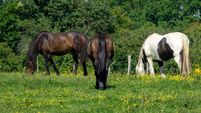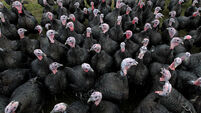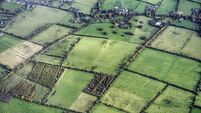Soaring demand for spring lamb

Demand for quality assured Irish lamb has continued to increase around two great religious festivals of Easter and Ramadam.
The fact that Easter fell two weeks later this year is expected to lead to stronger markets, while the ending of Ramadan in June should also boost the demand in Muslim countries.
Irish sheepmeat exports last year were estimated to have increased by 4% to €240m. The industry has 30,000 sheep farmers with up to 2.5m ewes. Output is estimated to be worth over €329m.
According to Bord Bia’s 2016-2017 report and outlook, retailers and foodservice buyers are increasingly looking towards Ireland as a source of quality product.
“This has helped Irish lamb carve a premium spot in the European market and with increased promotion activity planned in emerging markets over the next three years bodes well for Irish sheepmeat,” it said.
Those promotional efforts include a campaign by Bord Bia in Ireland, the Agriculture and Horticulture Development Board in the UK and Interview in France to highlight the versatility of European lamb as a quality everyday meal.
“Lamb. Tasty Easy Fun” also underlines the significance of a grass-based diet and the high welfare and sustainable credentials of the European sheep sector and the important contribution it makes to rural economies and local communities.
The agencies have invest €7.7m over the 36-month campaign, which continues for another year, with the remaining 50% being funded by the EU.
It is specifically targeting 25- to 45-year-olds in Ireland, Britain, France, Belgium, Germany, and Denmark after research showed that over 80% of lamb sales can be attributed to consumers aged 45 years and older.
It encourages younger consumers to consider lamb as an everyday meal option, however, and provide them with practical information on how to cook lamb and showcase the range of recipes.
However, domestic consumption in Ireland fell in 2016 following a reduction in prices of key competing proteins. Retail sales of lamb slowed in the second half of the year and for the 52 week-ending period of December 4 were back by over 8% in volume terms due to lower frequency of purchase.
SuperValu announced last week that it expects to sell €17m worth of Irish spring lamb this year, the equivalent of 225,000 lambs. The first of this new season Irish lamb is already on sale at selected SuperValu butcher counters across Ireland.
SuperValu’s Irish spring lamb is 100% Irish-born and bred, reared by Bord Bia Quality Assured farmers such as Co Roscommon-based Anthony Moran.
A supplier of SuperValu lamb for the last 20 years, Anthony keeps 200 ewes, maintaining the highest standards to ensure the best quality lamb for Irish consumers each year.
The retail group’s managing director, Martin Kelleher, said that, as the number one supporter of the Irish agri-food industry, SuperValu is committed to bringing the very best of locally-sourced fresh Irish produce to consumers.
“Our long-term partnerships with producers like Anthony Moran are key to delivering on our strategy of fresh food leadership,” he said.
Sheep farming in Ireland makes a positive social and environmental contribution in rural areas, particularly in remote places and on the hills, where it is not possible to conduct any other type of farming enterprise.
Following a challenging period for the industry, the prices paid to farmers for their sheep showed some signs of improvement in recent weeks.
Irish Farmers Association sheep committee chairman John Lynskey is predicted a strong demand for quality Irish lamb at Easter. He said that, with the high production costs and work involved, farmers would need a price in the order of €7.00/kg for spring lamb, a top quality product. However, the prices paid by meat factories were disappointing to date.
Meanwhile, a new scheme introduced by Agriculture Minister Michael Creed earlier this year provides funding of up to €25m for sheep farmers in 2017. It is part of Ireland’s Rural Development Programme, having been agreed with the European Commission.
Mr Creed also recently welcomed the signing of a contract between his department and Bord Bia for a campaign to promote beef and lamb in China, Japan, and Hong Kong.
Irish Cattle and Sheep Farmers Association sheep committee chairman John Brooks hailed the recent lifting of Saudi Arabia’s ban on Irish sheepmeat as a step in the right direction, as it provides more options for Irish sheep farmers.
The UK and France continue to be the core markets for Irish sheepmeat, accounting for just under 60% of total export volumes.
Key growth markets in Europe were Germany, Belgium, Sweden, and Denmark. Switzerland is the main non-EU destination for Irish sheepmeat, followed by Hong Kong.
There was a big increase in shipments to Switzerland making it one of the top five growth markets. Germany is now Ireland’s fourth largest market for lamb with a growing appreciation among consumers particularly in ethnic channels.
Sweden, our third largest market, performed strongly with volumes estimated at 5,000 tonnes in 2016. Ireland supplies almost one third of Sweden’s sheepmeat imports. It is our third largest market and is second to New Zealand as the country’s main import supplier. It has also secured a strong presence with Nordic retailers in private label and branded offering which has helped boost exports.
Market developments last year included a recovery in EU production and consumption, a rise in New Zealand shipments to the EU and higher Irish supplies offset by lower carcase weights.
Sheepmeat output in the EU is estimated to have recovered by almost 2% in 2016 to about 825,000 tonnes. This rise in production in the EU was largely driven by higher output in Spain, France and Ireland, offset by slightly lower UK output.









